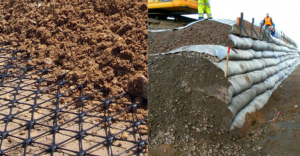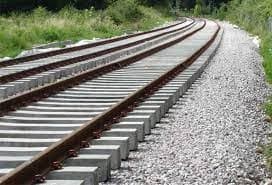Geogrid vs geotextile – What are the differences

Geosynthetics is made up of two words: Geo, which means “soil or earth,” and Synthetics, which means “man-made.” They are plastic-based man-made materials.
When introduced to biological tissue, these petrochemical-based polymers do not elicit a reaction or interact. Geosynthetics have the advantage of not decomposing due to fungal or bacterial activity, which is why they are employed to ameliorate soil conditions.
Geosynthetic materials come in a variety of shapes and sizes. The following are the categories of kinds utilised in agricultural applications:
- Geogrids
- Geotextiles
- Erosion control
- Geocells
- Geomembranes
In this essay, we’ll look at the distinctions between Geogrid and Geotextile. Many hardscape DIYers have trouble deciding which material to use. The distinctions are explained in this article.
What exactly is Geogrid?
These materials resemble open meshes and are made up of integrally linked polymers. Polyester, polyethylene, and polypropylene are used to make Geogrid.
They’re mostly utilised for soil or hardscape reinforcement and stability, such as strengthening retaining wall backfill in a variety of civil engineering applications.
Geogrids are most commonly employed in high-demand agricultural or heavy-load scenarios. As a result, they have a higher strength than other geotextile.
Geogrids are robust under tension due to their low strain, extending just 2 to 5% under load. Extruded geogrid, woven geogrid, and bonded geogrid are the three forms of geogrids.
a. Geogrids that have been extruded
These are made by stretching polymers or extruded integrated structures in uniaxial or biaxial directions.
When opposed to flexible woven and bonded geogrids, extruded geogrids are more stiff.
b. Woven Geogrids
These are made by weaving longitudinal and transverse ribs out of polypropylene coated polyester strands.
After that, knitting or interweaving is used to unite the crossings before an extra coating is applied to preserve the complete unit.
c. Geogrids that are bonded
Bonded geogrids are made by joining two or more sets of strands or other elements at right angles, as the name suggests.
What exactly is a Geotextile?
Any permeable textile utilised for dirt, soil, earth, or rock in any geotechnical engineering-related project, construction, or system is referred to as a geotextile.
For agricultural uses, it is the most frequently utilised geosynthetic material. Geotextiles are available in rolls that are up to 18 feet (5.6 metres) broad and 160 to 500 feet (50 to 150 metres) long.
Geo fabric and filter fabric are also available. These two textiles are permeable fabrics composed of polyester or polypropylene that are classed as woven or non-woven depending on how the yarns or threads are placed in the material.
a. Geotextile (woven)
The consistent and regular interweaving of yarns or threads in two directions creates cloth-like materials. Woven geotextiles feature a clear and quantifiable opening pattern as well as a regular visible manufacturing pattern.
They have a low strain, low elongation under load (usually up to 15%), and good tensile strength. They can be used for soil separation, load distribution, drainage, strengthening, and filtration because of their unique characteristics.
b. Geotextile (non-woven)
These are plain felt-like materials with no obvious design. Nonwoven geotextiles are made by randomly attaching threads in a mat via needle punching, heat bonding, or resin bonding.
Nonwoven geotextiles, unlike woven geotextiles, have a relatively high strain and stretch significantly under load (about 50 percent ).
As a result, they’re employed for drainage, load distribution, soil separation, and stability, but not for soil reinforcement like retaining walls.
The following are examples of geotextile separation applications:
- Pavements for automobile and truck traffic that are flexible or unsurfaced
- Routes to and from the construction site, as well as working platforms
- Caps for sludge ponds or an industrial waste lagoon
- Railway track layouts
- Yards for container storage
- Pavements for airfields that are flexible or stiff
- Fill pads and embankments of moderate height
Geotextiles and Geogrids: What’s the Difference?
- Geotextiles are used for separation, filtration, and drainage, whilst geogrids are designed to be used as a reinforcing material.
- Any form of fill is unlikely to be separated by a geogrid. When the subgrade soils get wet, for example, water can readily flow through the geogrid perforations. The geotextile, on the other hand, can allow water to freely flow from the soil to the aggregate layer and vice versa.
- In general, geogrids appear to be a superior kind of reinforcement since the soil interlocks with the grid membrane; nevertheless, the geotextile offers the separation function that guarantees it maintains its thickness, service life, and long-term strength.
- Geotextiles are frictional resistance dependent reinforcement, whereas geogrids are passive resistance dependent.
- Grading, evacuating, and allowing vegetation are all part of the geotextile installation process.
- Directly applying the separating geotextile to the prepared subgrade
The installation of a geogrid entails the following steps:
- The geogrid retaining wall is being planned.
- Evacuating
- Stabilization of the sub-base and base
- Leveling gravel
- Putting up a retaining wall
- Putting it all together in a nutshell
So that’s the distinction between geogrid and geotextile. Please do not hesitate to contact our experts for additional information on the installation of geosynthetic materials in civil engineering and the building sector.


